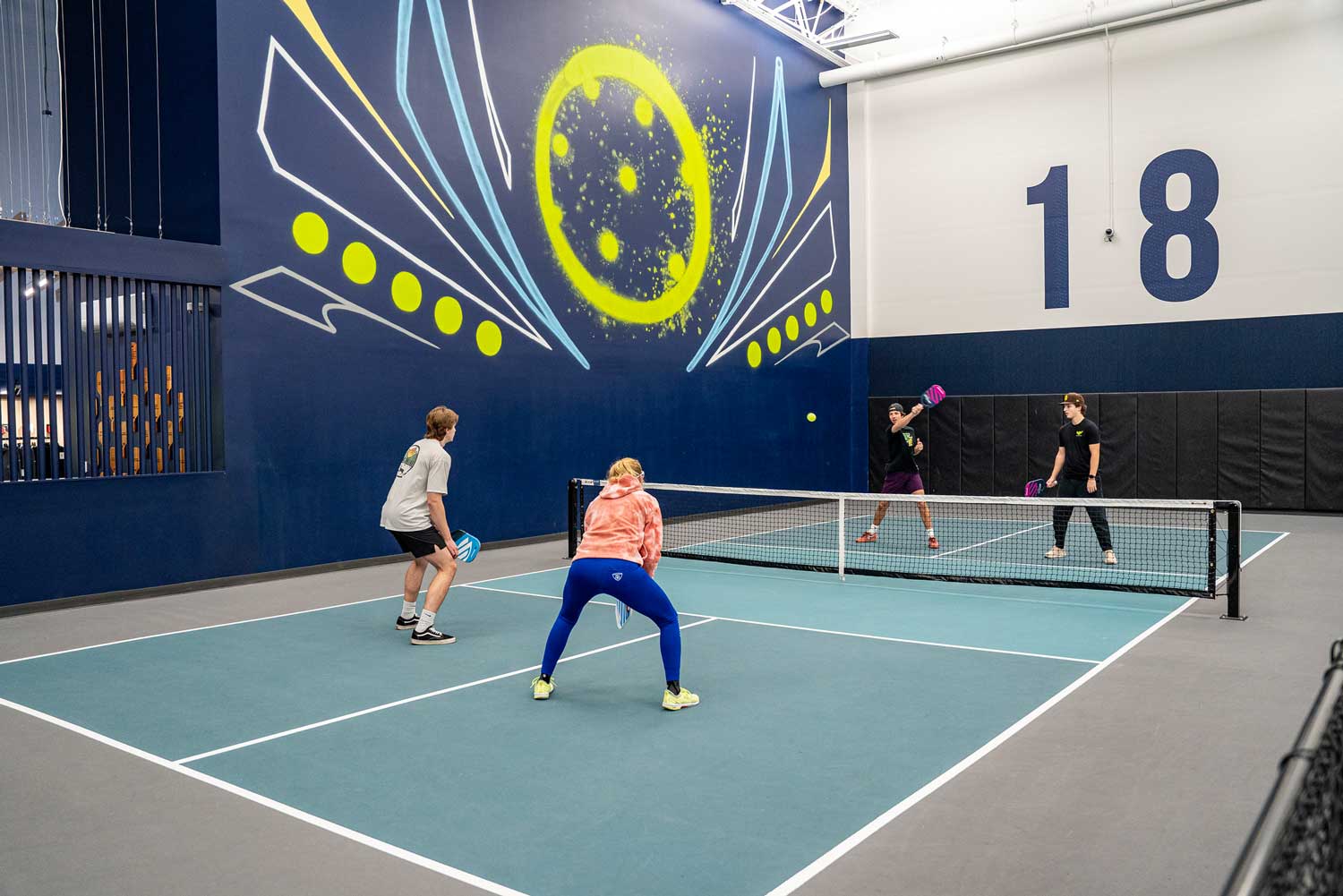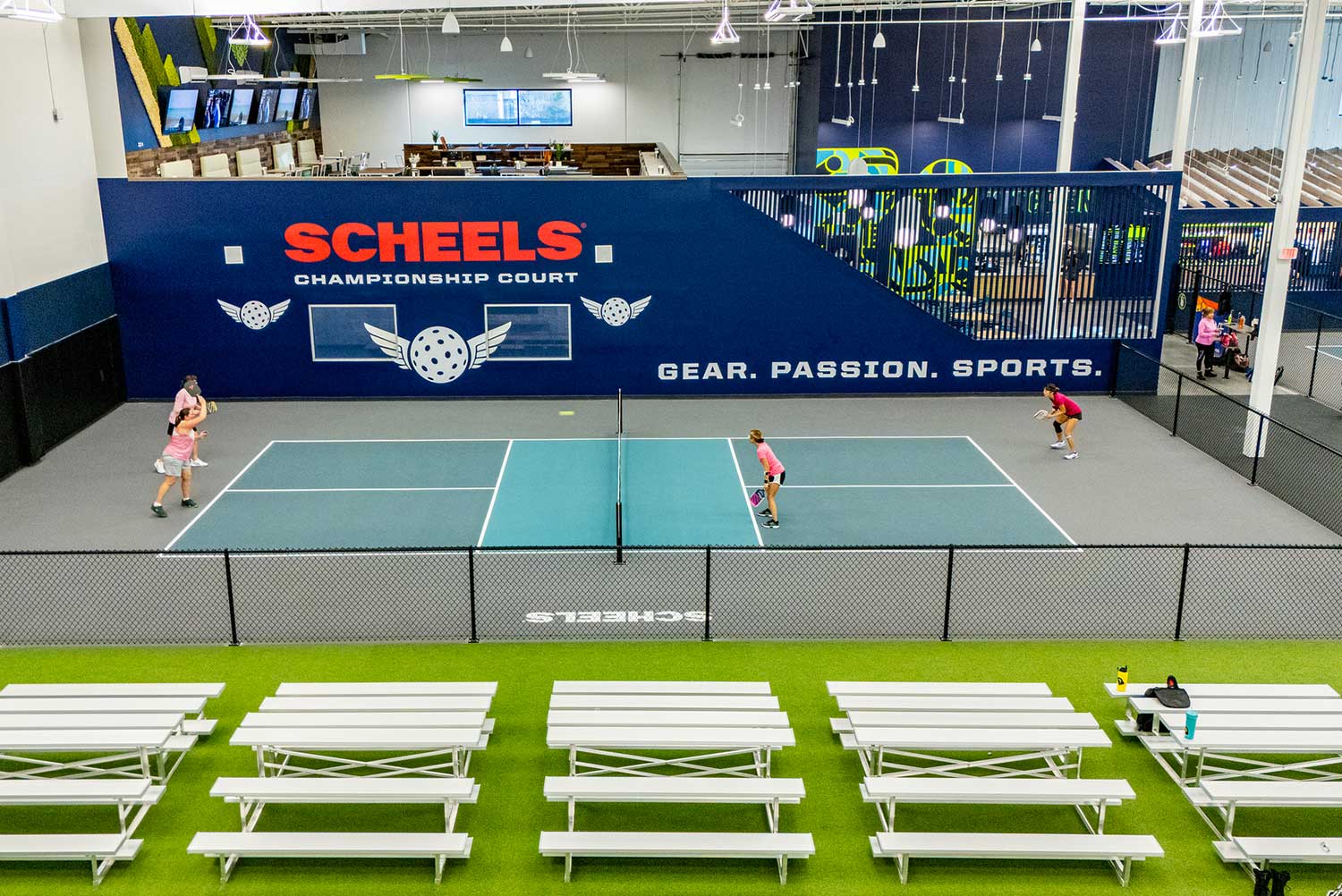A Game Changer: Transforming Industrial Space into a Premium Pickleball Venue
By now, you may have heard of the relatively new, yet rapidly popular sport of pickleball. A paddle sport combining elements of badminton, tennis, and ping pong, it’s celebrated as being suitable for people of all ages and fitness levels. Per the sport’s origin story, in 1965, Joel Pritchard, a congressman from Washington State and his friend and businessman, Bill Bell, invented the game at Pritchard’s home on Bainbridge Island, Washington. They were looking for something entertaining to do with their families and had a variety of mismatched sporting equipment as well as an old badminton court on the property — they combined it all together, established the rules, refined the court, and the rest is history.
At the beginning of 2023, our team had the opportunity to be part of this history, helping to bring the sport of pickleball to the Treasure Valley. We were contracted as the design team to repurpose an industrial warehouse space into what would become The Flying Pickle in Meridian, Idaho. These types of industrial and manufacturing warehouses can be the perfect backdrop for alternative uses when outfitted for sports and entertainment tenants — and this is exactly what we did!
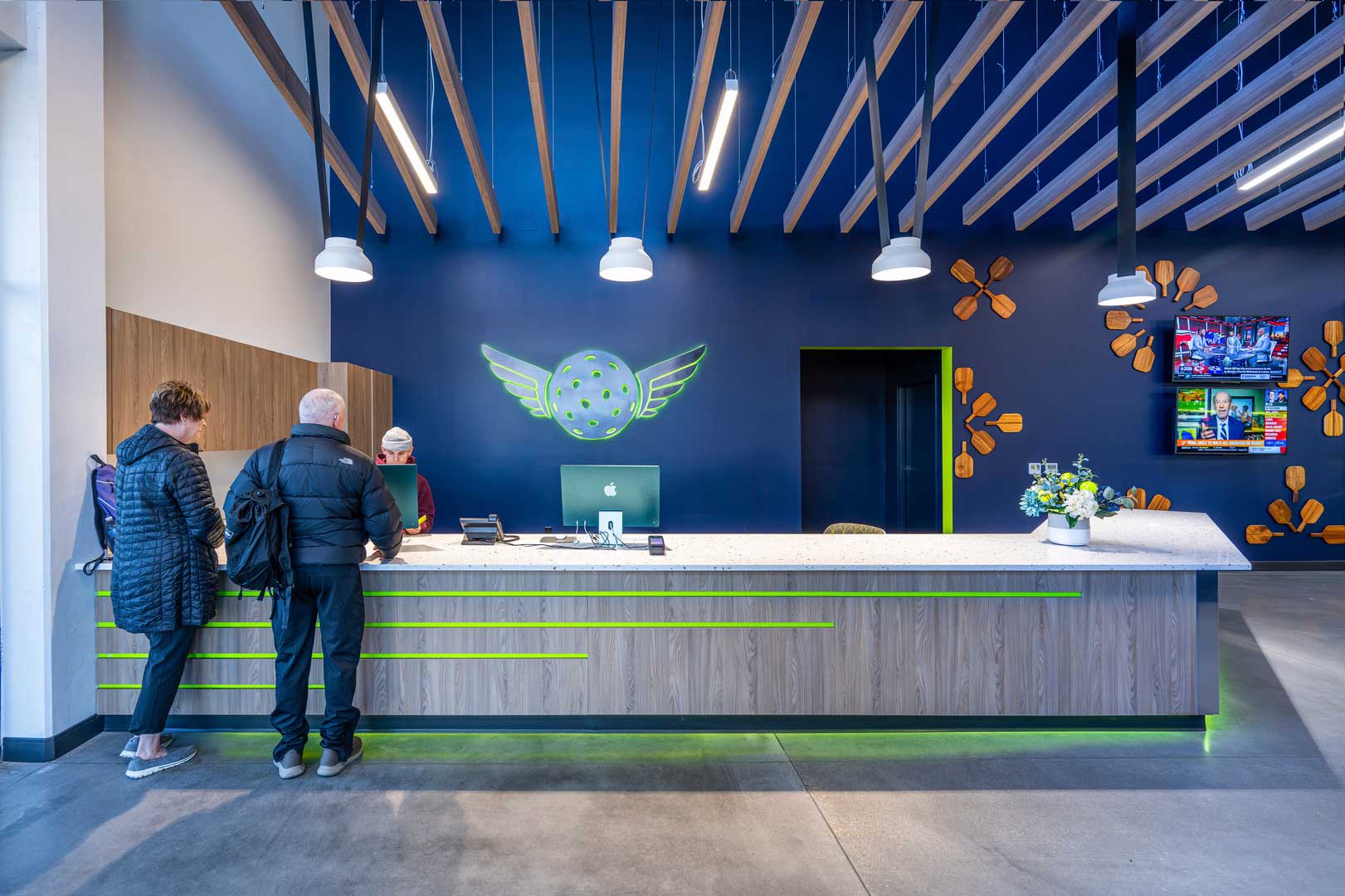
The Flying Pickle has a welcoming, invigorating, and modern vibe with colors, materials, and features that reflect the sport’s place of origin, Bainbridge Island, Washington.
Our Mission and Inspiration
The Flying Pickle owners set out with a mission to create the Treasure Valley’s first premium, indoor pickleball facility, offering the best pickleball experience in the nation. They wanted The Flying Pickle to not only be a place to play pickleball, but also a home away from home for the growing, local pickleball community. Much like the game’s family-centered origin, The Flying Pickle welcomes multi-generational club members — from beginners who are looking to learn the sport to more expert players who want to master their game.
In creating this flagship home, our design team looked to the origins of pickleball for inspiration. For example, we drew from the original wood paddle and the flora of Bainbridge Island on the Puget Sound when it came to selecting colors, textures, and materials. We wanted the setting to subtly harken back to the origins of the sport, while conveying an invigorating, modern spirit. Our overall goals were to incorporate cutting-edge elements specific to pickleball — such as dynamic and innovative courts — with surrounding spaces and amenities that foster community and member connections, where people can gather to enjoy time with friends and family.
The Research Behind the Design
At Cushing Terrell, our design process begins and ends with research, and in the case of this project, there was a fair amount of front-end learning and knowledge-sharing. Two of the founders of The Flying Pickle are professional pickleball players, which meant our team had access to information that lent to incredible attention to detail and savvy when it came to the technicalities that make for a great playing experience.
We deliberated over the question: Why would people want to become members of The Flying Pickle? And two primary reasons rose to the top: 1) the comradery of pickleball culture and 2) an elevated club experience. As the original purpose of the game was something the whole family could play together, our intention was to create a feeling of community, celebrate family and multi-generational players, and make it fun to be in the space regardless of whether you are playing or not.
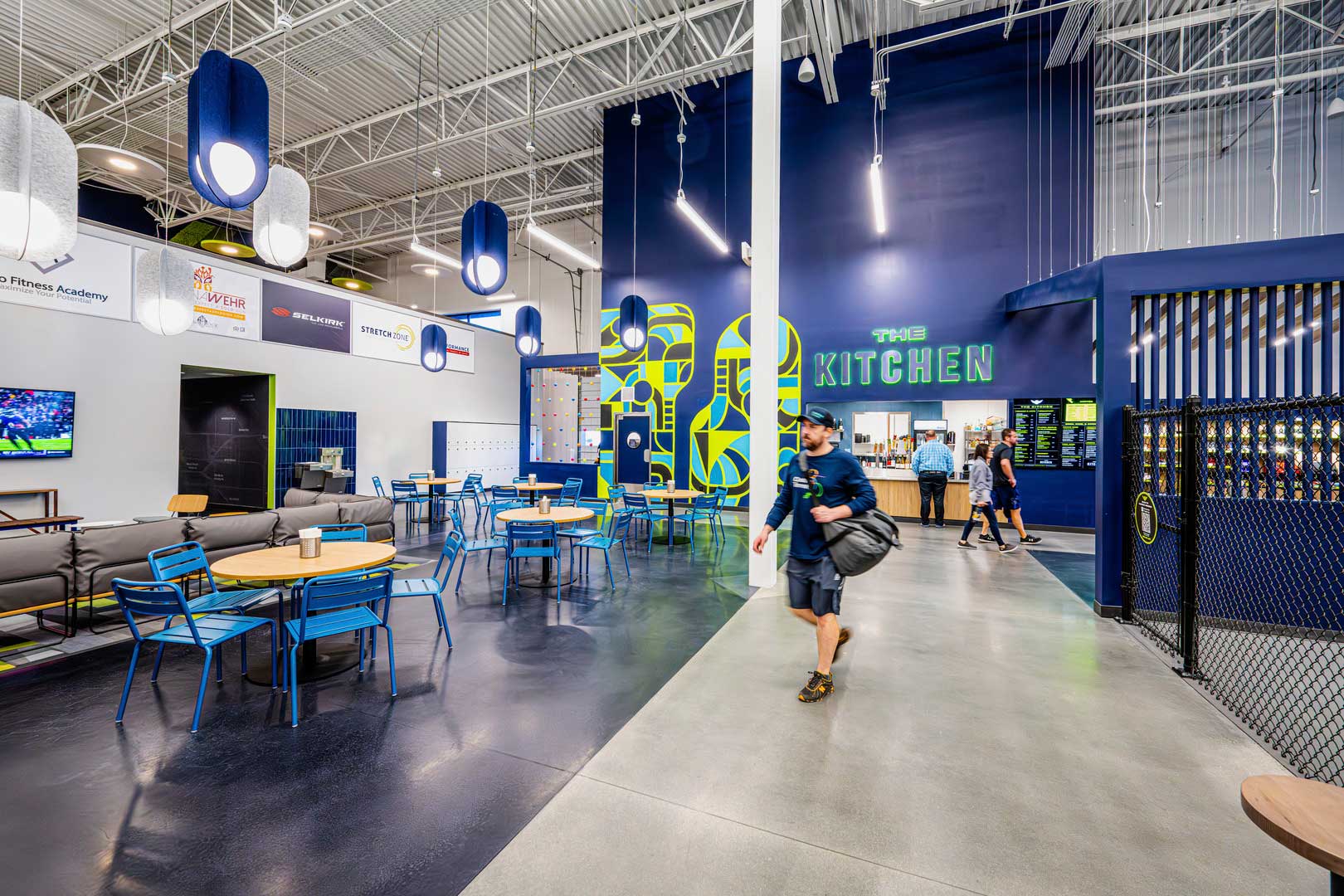
The entry, reception, and overall club layout were designed to make members feel welcome, at home, and autonomous in the facility. The design is also meant to impress non-members and get them excited about playing pickleball and potentially joining the club.
Design Strategies to Support the User Experience
How a venue is laid out is one of the major factors that impact the user experience — from how it feels when you first enter the building to how all the spaces and activities function within. Our approach to the layout of this nearly 49,000 sq. ft. building was what we called the “reverse mullet,” with the party in the front and business in the back — and by business, we mean playing the game.
The front of the building serves as the community zone and includes a pro shop, restaurant, lounge, locker/shower rooms, and flex room that can be rented for parties and events. The rest of the building behind is filled with courts. When first passing through the building entry on the first floor, the full expanse of the space is not realized until you exit the pro shop and are met with the full height of the building, 17 courts, and a mezzanine area for maximum viewing potential. The energy flexes along the building’s “spine” with spectator areas sectioned off through the center and in between some of the courts.

The spacious facility with premium amenities for club members, combined with professional-grade courts, makes for a world-class pickleball venue.
The carefully considered and purposeful design of the entry, reception, and club layout are meant to ensure members feel welcome, at home, and autonomous in the facility. We also wanted the design to impress non-members and get them excited about playing and potentially joining the club. Custom artwork, including two large murals by local artists, celebrate the sport of pickleball, adding interest and depth of experience to the space. A wooden paddle exhibit honors the origin of the pickleball paddle, and a founders wall features the names of all major donors and contributors to the facility. An acoustic moss installation provides a biophilic element as well as controls some of the noise transfer that comes from the courts. A colorful pickleball-motif screen separates a quieter respite area from the livelier lounge area.
High-Performance Design
To create the “best pickleball experience in the nation,” we needed to provide very specific solutions related to acoustics, lighting, court materials, and the HVAC system.
People love pickleball, but they aren’t as keen on the noise. To come up with the ideal acoustic strategies and materials, our interior design team did in-depth acoustic analysis of the space and proposed acoustic products to ensure the sound levels would be comfortable for players and spectators. We improvised test courts within the warehouse building and considered numerous combinations of materials to get to our target reverberation coefficients. In the end, we combined acoustic ceiling baffles, acoustic lighting products, a moss wall (mentioned earlier), and a special type of sports flooring to minimize noise and noise transfer.
The pickleball courts feature professional, cushion flooring to support comfortable movement while the colors chosen enable players to easily see the pickleballs. A thoroughfare for spectators runs up the “spine” of the building so people can watch each game.
Another tricky part of the design was choosing the correct lighting. This may sound simple, but with the great expanse of the space and incredibly high ceilings, along with the need to have clear vision for playing, we needed to carefully consider the type of lights and their placement. For this project, we utilized high-output, indirect sports lighting where the light source faces away from rather than toward the viewer. With lights covered at the bottom and shining up toward the ceiling, we can avoid shadows and hotspots. And there are no bright lights shining down on players causing distractions at the top of their vision. Because our clients had a goal to host championship games at the Flying Pickle, this meant incorporating super functional, state-of-the-art lighting solutions.
When it came to choosing the floor material for the courts, we had professionals to guide us. To enable a destination place for competitions, we used professional-grade cushion flooring to support the movement of the players, making for a comfortable experience, while the colors chosen make it so players can clearly see the pickleballs. The specialized texture of the sports floor is ideal for non-slip pickleball play, but not so rough as to impact the life of the pickleballs.
Regarding the HVAC system, one of the big moves was designing dehumidifiers into the system to remove moisture (sweat) from the air in the playing areas. It’s one of those details that may seem small, but is super important to the technical design of a sports facility. The HVAC system was also designed with three roof-top units with demand-control ventilation, combined with 21 fan coils for the front of the house and 11 destratification fans to mix the air in the high-ceiling court area. Carbon dioxide sensors monitor and modulate the air flow, adding fresh air when the CO2 levels get too high, in particular when there are a lot of players on the courts. Overall, the system was designed to ensure the best possible indoor air quality and a healthy environment for both people playing and watching the game.
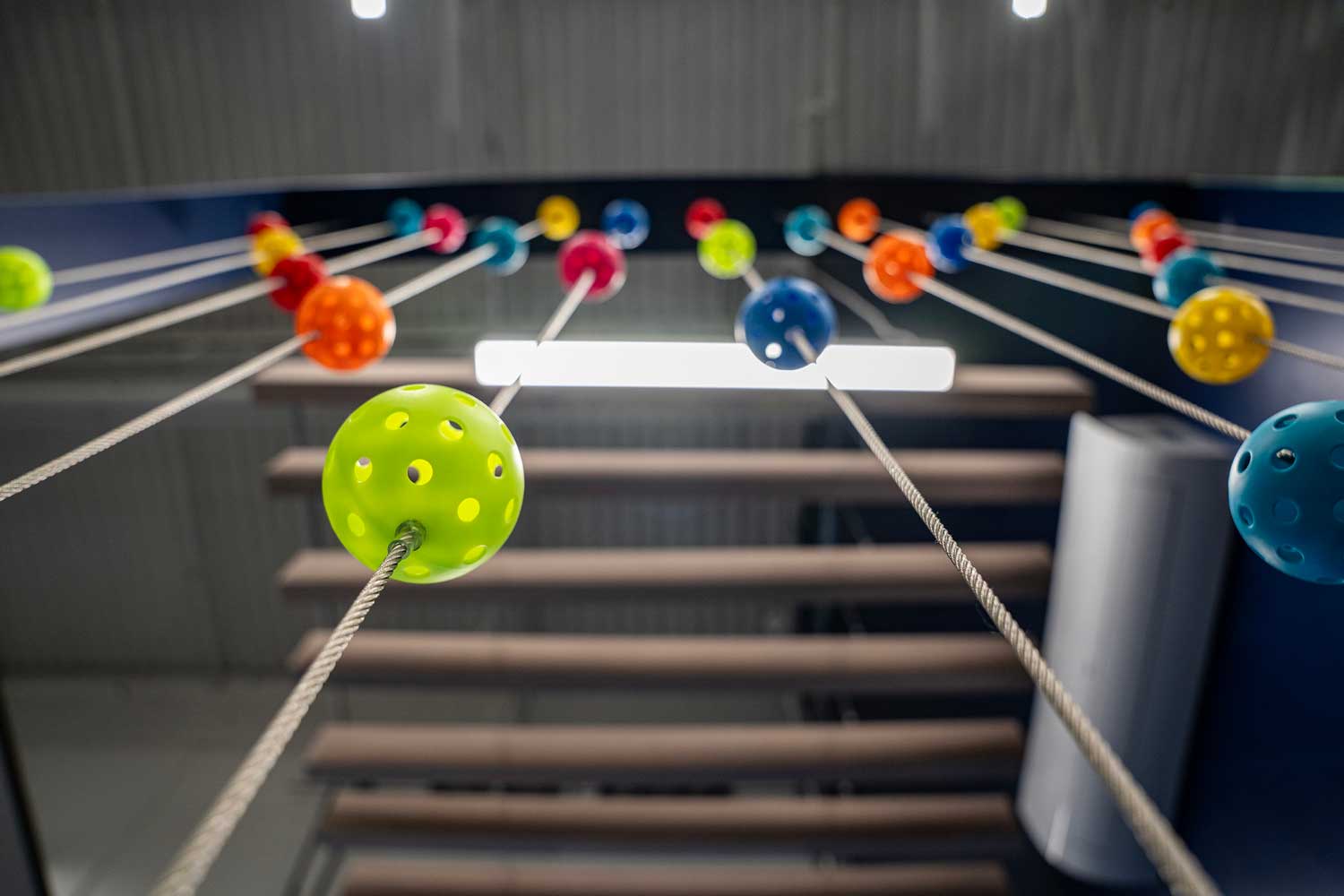
Creative, pickleball-themed art installations are featured throughout the building giving the space a great energy.
A Lively Addition to Treasure Valley Sports and Entertainment
All in all, this was a great project to work on, and we hope to do more pickleball facilities in the future! This is a great example of an alternative use for industrial warehouse space, and in the case of The Flying Pickle, it became an additional venue in an area that has become a destination for recreation spaces — including the K1 Speed go-cart racing track next door, which was also designed by our Cushing Terrell team.

